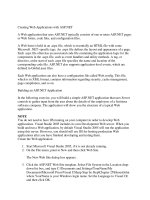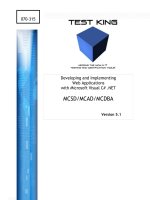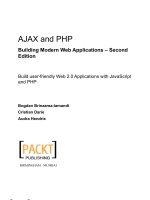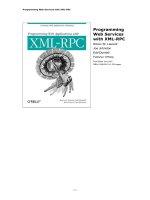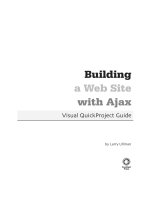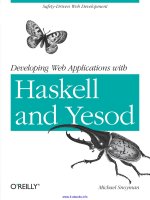ReactJS by example building modern web applications with react
Bạn đang xem bản rút gọn của tài liệu. Xem và tải ngay bản đầy đủ của tài liệu tại đây (2.66 MB, 280 trang )
[1]
ReactJS by Example - Building
Modern Web Applications
with React
Get up and running with ReactJS by developing five
cutting-edge and responsive projects
Vipul A M
Prathamesh Sonpatki
BIRMINGHAM - MUMBAI
ReactJS by Example - Building Modern Web
Applications with React
Copyright © 2016 Packt Publishing
All rights reserved. No part of this book may be reproduced, stored in a retrieval
system, or transmitted in any form or by any means, without the prior written
permission of the publisher, except in the case of brief quotations embedded in
critical articles or reviews.
Every effort has been made in the preparation of this book to ensure the accuracy
of the information presented. However, the information contained in this book is
sold without warranty, either express or implied. Neither the authors, nor Packt
Publishing, and its dealers and distributors will be held liable for any damages
caused or alleged to be caused directly or indirectly by this book.
Packt Publishing has endeavored to provide trademark information about all of the
companies and products mentioned in this book by the appropriate use of capitals.
However, Packt Publishing cannot guarantee the accuracy of this information.
First published: April 2016
Production reference: 1110416
Published by Packt Publishing Ltd.
Livery Place
35 Livery Street
Birmingham B3 2PB, UK.
ISBN 978-1-78528-964-4
www.packtpub.com
Credits
Authors
Vipul A M
Project Coordinator
Kinjal Bari
Prathamesh Sonpatki
Proofreader
Reviewers
Safis Editing
Muhammad Arslan
Pawel Czekaj
Matt Goldspink
Commissioning Editor
Dipika Gaonkar
Acquisition Editor
Larissa Pinto
Content Development Editor
Mamata Walkar
Technical Editor
Bharat Patil
Copy Editor
Vibha Shukla
Indexer
Monica Ajmera Mehta
Graphics
Disha Haria
Production Coordinator
Arvindkumar Gupta
Cover Work
Arvindkumar Gupta
About the Authors
Vipul A M is Director at BigBinary. He is part of Rails Issues Team, and helps
triaging issues. His spare time is spent exploring and contributing to many Open
Source ruby projects, when not dabbling with React JS.
Vipul loves Ruby's vibrant community and helps in building PuneRb, is the founder
of and runs RubyIndia Community Newsletter and RubyIndia Podcast, and
organizes Deccan Ruby Conference in Pune.
He can be found @vipulnsward on twitter and on his site .
Prathamesh Sonpatki is Director at BigBinary. He builds web applications using
Ruby on Rails and ReactJS. He loves learning new programming languages and
contributing to open source.
He can be found @_cha1tanya on twitter.
About the Reviewers
Muhammad Arslan has been working in different roles: Senior IT-Developer,
IT-Consultant, TechLead and Architect. He has vast experience of frontend and
backend technologies and agile development. He has two master's degrees in
Software Engineering and E-commerce. He has done his master's thesis in
Usability and User Experience. He is also Oracle Certified Professional,
Java Programmer (OCPJP).
He is currently working in biggest Nordic bank Nordea as Senior IT-Developer.
He has previously worked in Digital River World Payments on bank gateway/iso
connections and designed user interfaces. He worked in Accedo on SmartTV
applications and application management products as well.
You can follow him on Twitter @arslan_mecom or you can check out his blog
/>
I would like to thank my mother, father (late), and my better half, for
their continuous support for making me successful in my career.
Pawel Czekaj has a bachelor's degree in computer science. He is a web developer
with strong backend (PHP, Java, MySQL, and Unix system) and frontend (AngularJS,
Backbone, React.js, and jQuery) experience. He loves JavaScript, React.js, and
Angular.js. Previously, he worked as a senior full stack web developer. Currently, he
is working as a frontend developer for Cognifide and Toptal. You can contact him at
.
Matt Goldspink is currently the lead engineer at Vlocity, Inc., based in San
Francisco, working on their mobile and web platforms. Prior to this, he has held
various roles at startups, banks, and also spent time as a technology trainer. Matt
was the lead developer and architect for the award-winning mobile web platform
for one of the world's leading investment banks.
www.PacktPub.com
Support files, eBooks, discount offers, and more
For support files and downloads related to your book, please visit www.PacktPub.com.
Did you know that Packt offers eBook versions of every book published, with PDF
and ePub files available? You can upgrade to the eBook version at www.PacktPub.com
and as a print book customer, you are entitled to a discount on the eBook copy. Get in
touch with us at for more details.
At www.PacktPub.com, you can also read a collection of free technical articles, sign
up for a range of free newsletters and receive exclusive discounts and offers on Packt
books and eBooks.
TM
/>
Do you need instant solutions to your IT questions? PacktLib is Packt's online digital
book library. Here, you can search, access, and read Packt's entire library of books.
Why subscribe?
• Fully searchable across every book published by Packt
• Copy and paste, print, and bookmark content
• On demand and accessible via a web browser
Free access for Packt account holders
If you have an account with Packt at www.PacktPub.com, you can use this to access
PacktLib today and view 9 entirely free books. Simply use your login credentials for
immediate access.
Table of Contents
Prefacev
Chapter 1: Getting Started with React
1
What is React?
When Shawn meets Mike and ReactJS
Requiring React library
Building our first component
Back to work
Displaying static data
Passing data to components
Summary
2
3
6
6
10
12
15
20
Chapter 2: JSX in Depth
21
Chapter 3: Data Flow and Life Cycle Events
45
Why JSX?
22
Transforming JSX into JavaScript
23
HTML tags vs React components
24
Self closing tag
25
Multiple components
25
JavaScript expressions
31
Namespaced components
32
Spread attributes
35
Styles in JSX
36
JSX Gotchas
38
Conditionals in JSX
40
Non-DOM attributes
41
Summary43
Data flow in React
Props validation
[i]
46
47
Table of Contents
Specifying default props
49
Modifying this.props.children
50
State51
Setting initial state
52
Setting state
52
Avoiding state
52
State versus props
53
Component life cycle overview
54
Component life cycle methods
55
Summary62
Chapter 4: Composite Dynamic Components and Forms
63
Chapter 5: Mixins and the DOM
91
Forms in React
Setting up the application
Getting started with forms
Interactive props
Controlled components
Uncontrolled components
Getting started with form wizard
Form events
Parent Child relationship
Form validation
Shipping details step
Delivery details step
Summary
Back at the office
Adding a modal
Refs
Summary
63
64
66
68
68
70
70
74
76
79
81
85
90
91
103
105
107
Chapter 6: React on the Server
109
Chapter 7: React Addons
127
Getting React to render on server
109
On the server
124
Summary126
Getting started with Addons
Immutability helpers
Available commands
Cloning components
Helpers for testing React apps
127
128
132
133
139
Setting up Jest
139
[ ii ]
Table of Contents
Testing structure of React components
141
Testing behavior of React components
142
Shallow rendering
144
Summary145
Chapter 8: Performance of React Apps
147
Chapter 9: React Router and Data Models
167
Chapter 10: Animation
185
Chapter 11: React Tools
203
Performance of React apps
147
Virtual DOM
148
The PERF addon
148
DOM operations performed by React
150
Time taken to render all the components
151
Time wasted by React
152
The shouldComponentUpdate hook
157
PureRenderMixin161
The PureRenderMixin anti pattern
163
Immutable data
164
Summary166
A new adventure
168
Creating Backbone models
170
Incorporating defined Backbone models
172
Data models and Backbone
182
Summary184
Fun stuff at Adequate LLC!
186
Model updates
187
Animate193
Summary
201
Development tools
203
Using Babel for ES6 and JSX
204
ESLint205
React Dev Tools
208
Build tools
210
What is Webpack?
210
Webpack configuration
211
Loaders213
Hot module replacement
214
Summary218
[ iii ]
Table of Contents
Chapter 12: Flux
219
Chapter 13: Redux and React
243
Flux architecture and unidirectional flow
220
Flux actions
225
Flux stores
230
Summary242
Redux244
Setting up Redux
246
Summary258
Index259
[ iv ]
Preface
ReactJS is an open source JavaScript library that intends to bring aspects of reactive
programming to web applications and sites. It aims to address the challenges
encountered in developing single-page applications. React's core principles are
declarative code, efficiency, flexibility, and improved developer experience.
What better way of learning a new technology than diving deep into it while
working on something? This book will guide you with the help of different projects,
each focusing on the specific features of React in your journey of mastering React.
We will cover everything from JSX, add-ons, performance, and Redux.
Let the journey commence!
What this book covers
Chapter 1, Getting Started with React, covers the basics of ReactJS by building a simple
app with static data. We will study top-level API of React and its basic building blocks.
Chapter 2, JSX in Depth, does a deep dive into JSX and how to use it with React. We
will also look at a few gotchas that need to be considered while working with JSX.
Chapter 3, Data Flow and Life Cycle Events, focuses on data flow between React
components and complete life cycle of a component.
Chapter 4, Composite Dynamic Components and Forms, shows how to build composite
dynamic components using React with more focus on forms while building a form
wizard application.
Chapter 5, Mixins and the DOM, covers mixins, refs, and how React interacts
with DOM.
[v]
Preface
Chapter 6, React on the Server, uses React on the server side to render HTML and
learn more about what server-side rendering brings to the table by building a
search application based on Open Library Books API.
Chapter 7, React Addons, continues to use the search application and enhances it with
various add-ons provided with React. We will study the use cases of these add-ons.
Chapter 8, Performance of React Apps, discusses everything about the performance of
the React app by going deep into how React renders the content and helps in making
our apps faster.
Chapter 9, React Router and Data Models, helps in building a Pinterest-style application
and discusses routing using react-router. We will also discuss how various data
models can be used with React, including Backbone models.
Chapter 10, Animation, focuses on making our Pinterest app more interactive with
animations and how to use them effectively with React.
Chapter 11, React Tools, takes a step back and discusses various tools that we will
use in our journey while working with React. We will study the tools such as Babel,
ESLint, React dev tools, and Webpack.
Chapter 12, Flux, explains how to build a social media-tracker application while using
the Flux architecture. We will discuss the need for the Flux architecture and what it
brings to the table.
Chapter 13, Redux and React, covers using Redux—a popular state management
library—to enhance the social media-tracker application further in order to use
Redux-based state management.
What you need for this book
You will need to have a modern web browser, such as Chrome or Firefox, to run the
examples from the book. You will also need to have Node.js— />en/—installed with the npm package manager set up. Additional setup instructions
can be found at />
Who this book is for
If you are a web developer and wish to learn ReactJS from scratch, then this book is
tailor-made for you. Good understanding of JavaScript, HTML, and CSS is expected.
[ vi ]
Preface
Conventions
In this book, you will find a number of text styles that distinguish between different
kinds of information. Here are some examples of these styles and an explanation of
their meaning.
Code words in text, database table names, folder names, filenames, file extensions,
pathnames, dummy URLs, user input, and Twitter handles are shown as follows:
"Notice, how we are using this.props.headings to access the passed information
about headings."
A block of code is set as follows:
return <div>
Recent Changes
<table>
….
</table>
</div>
…
When we wish to draw your attention to a particular part of a code block, the
relevant lines or items are set in bold:
TestUtils.Simulate.click(submitButton);
expect(app.state.searching).toEqual(true);
expect(app.state.searchCompleted).toEqual(false);
let spinner = TestUtils.findRenderedComponentWithType(app,
Spinner);
expect(spinner).toBeTruthy();
Any command-line input or output is written as follows:
Listening at localhost:9000
Hash: 8ec0d12965567260413b
Version: webpack 1.9.11
Time: 1639ms
New terms and important words are shown in bold. Words that you see on the
screen, for example, in menus or dialog boxes, appear in the text like this: "Did you
notice the Auto-run JS option?"
[ vii ]
Preface
Warnings or important notes appear in a box like this.
Tips and tricks appear like this.
Reader feedback
Feedback from our readers is always welcome. Let us know what you think about
this book—what you liked or disliked. Reader feedback is important for us as it helps
us develop titles that you will really get the most out of.
To send us general feedback, simply e-mail , and mention
the book's title in the subject of your message.
If there is a topic that you have expertise in and you are interested in either writing
or contributing to a book, see our author guide at www.packtpub.com/authors.
Customer support
Now that you are the proud owner of a Packt book, we have a number of things to
help you to get the most from your purchase.
Downloading the example code
You can download the example code files for this book from your account at
. If you purchased this book elsewhere, you can visit
and register to have the files e-mailed directly
to you.
You can download the code files by following these steps:
1. Log in or register to our website using your e-mail address and password.
2. Hover the mouse pointer on the SUPPORT tab at the top.
3. Click on Code Downloads & Errata.
4. Enter the name of the book in the Search box.
5. Select the book for which you're looking to download the code files.
6. Choose from the drop-down menu where you purchased this book from.
7. Click on Code Download.
[ viii ]
Preface
Once the file is downloaded, please make sure that you unzip or extract the folder
using the latest version of:
• WinRAR / 7-Zip for Windows
• Zipeg / iZip / UnRarX for Mac
• 7-Zip / PeaZip for Linux
Errata
Although we have taken every care to ensure the accuracy of our content, mistakes
do happen. If you find a mistake in one of our books—maybe a mistake in the text or
the code—we would be grateful if you could report this to us. By doing so, you can
save other readers from frustration and help us improve subsequent versions of this
book. If you find any errata, please report them by visiting ktpub.
com/submit-errata, selecting your book, clicking on the Errata Submission Form
link, and entering the details of your errata. Once your errata are verified, your
submission will be accepted and the errata will be uploaded to our website or added
to any list of existing errata under the Errata section of that title.
To view the previously submitted errata, go to />content/support and enter the name of the book in the search field. The required
information will appear under the Errata section.
Piracy
Piracy of copyrighted material on the Internet is an ongoing problem across all
media. At Packt, we take the protection of our copyright and licenses very seriously.
If you come across any illegal copies of our works in any form on the Internet, please
provide us with the location address or website name immediately so that we can
pursue a remedy.
Please contact us at with a link to the suspected
pirated material.
We appreciate your help in protecting our authors and our ability to bring you
valuable content.
Questions
If you have a problem with any aspect of this book, you can contact us at
, and we will do our best to address the problem.
[ ix ]
Getting Started with React
Web development has seen a huge advent of Single Page Application (SPA) in the
past couple of years. Early development was simple—reload a complete page to
perform a change in the display or perform a user action. The problem with this was
a huge round-trip time for the complete request to reach the web server and back to
the client.
Then came AJAX, which sent a request to the server, and could update parts of the
page without reloading the current page. Moving in the same direction, we saw the
emergence of the SPAs.
Wrapping up the heavy frontend content and delivering it to the client browser just
once, while maintaining a small channel for communication with the server based on
any event; this is usually complemented by thin API on the web server.
The growth in such apps has been complemented by JavaScript libraries and
frameworks such as Ext JS, KnockoutJS, BackboneJS, AngularJS, EmberJS,
and more recently, React and Polymer.
Let's take a look at how React fits in this ecosystem and get introduced to it in
this chapter.
[1]
Getting Started with React
In this chapter, we will cover the following topics:
• What is React and why do we use React?
• Data flows in the component
• Component displays the view based on state of the component
• Component defines display of the view, irrespective of data contained, thus
reducing the dependency and complexity of state for display
• User interactions may change state of component from handlers
• Components are reused and re-rendered
What is React?
ReactJS tries to solve the problem from the View layer. It can very well be defined
and used as the V in any of the MVC frameworks. It's not opinionated about how it
should be used. It creates abstract representations of views. It breaks down parts of
the view in the Components. These components encompass both the logic to handle
the display of view and the view itself. It can contain data that it uses to render the
state of the app.
To avoid complexity of interactions and subsequent render processing required,
React does a full render of the application. It maintains a simple flow of work.
React is founded on the idea that DOM manipulation is an expensive operation and
should be minimized. It also recognizes that optimizing DOM manipulation by hand
will result in a lot of boilerplate code, which is error-prone, boring, and repetitive.
React solves this by giving the developer a virtual DOM to render to instead of the
actual DOM. It finds difference between the real DOM and virtual DOM and conducts
the minimum number of DOM operations required to achieve the new state.
React is also declarative. When the data changes, React conceptually hits the refresh
button and knows to only update the changed parts.
This simple flow of data, coupled with dead simple display logic, makes
development with ReactJS straightforward and simple to understand.
Who uses React? If you've used any of the services such as Facebook, Instagram,
Netflix, Alibaba, Yahoo, E-Bay, Khan-Academy, AirBnB, Sony, and Atlassian, you've
already come across and used React on the Web.
In just under a year, React has seen adoption from major Internet companies in their
core products.
[2]
Chapter 1
In its first-ever conference, React also announced the development of React Native.
React Native allows the development of mobile applications using React. It transpiles
React code to the native application code, such as Objective-C for iOS applications.
At the time of writing this, Facebook already uses React Native in its Groups and
Ads Manager app.
In this book, we will be following a conversation between two developers, Mike
and Shawn. Mike is a senior developer at Adequate Consulting and Shawn has
just joined the company. Mike will be mentoring Shawn and conducting pair
programming with him.
When Shawn meets Mike and ReactJS
It's a bright day at Adequate Consulting. Its' also Shawn's first day at the company.
Shawn had joined Adequate to work on its amazing products and also because it
uses and develops exciting new technologies.
After onboarding the company, Shelly, the CTO, introduced Shawn to Mike. Mike, a
senior developer at Adequate, is a jolly man, who loves exploring new things.
"So Shawn, here's Mike", said Shelly. "He'll be mentoring you as well as pairing with
you on development. We follow pair programming, so expect a lot of it with him.
He's an excellent help."
With that, Shelly took leave.
"Hey Shawn!" Mike began, "are you all set to begin?"
"Yeah, all set! So what are we working on?"
[3]
Getting Started with React
"Well we are about to start working on an app using />Open Library is collection of the world's classic literature. It's an open, editable library
catalog for all the books. It's an initiative under and lists
free book titles. We need to build an app to display the most recent changes in the
record by Open Library. You can call this the Activities page. Many people contribute
to Open Library. We want to display the changes made by these users to the books,
addition of new books, edits, and so on, as shown in the following screenshot:
"Oh nice! What are we using to build it?"
"Open Library provides us with a neat REST API that we can consume to fetch the
data. We are just going to build a simple page that displays the fetched data and
format it for display. I've been experimenting and using ReactJS for this. Have you
used it before?"
"Nope. However, I have heard about it. Isn't it the one from Facebook and Instagram?"
[4]
Chapter 1
"That's right. It's an amazing way to define our UI. As the app isn't going to have
much of logic on the server or perform any display, it is an easy option to use it."
"As you've not used it before, let me provide you a quick introduction."
"Have you tried services such as JSBin and JSFiddle before?"
"No, but I have seen them."
"Cool. We'll be using one of these, therefore, we don't need anything set up on our
machines to start with."
"Let's try on your machine", Mike instructed. "Fire up http://jsbin.
com/?html,output"
"You should see something similar to the tabs and panes to code on and their output
in adjacent pane."
"Go ahead and make sure that the HTML, JavaScript, and Output tabs are clicked
and you can see three frames for them so that we are able to edit HTML and JS and
see the corresponding output."
"That's nice."
"Yeah, good thing about this is that you don't need to perform any setups. Did you
notice the Auto-run JS option? Make sure its selected. This option causes JSBin to
reload our code and see its output so that we don't need to keep saying Run with JS
to execute and see its output."
"Ok."
[5]
Getting Started with React
Requiring React library
"Alright then! Let's begin. Go ahead and change the title of the page, to say, React
JS Example. Next, we need to set up and we require the React library in our file."
"React's homepage is located at Here, we'll
also locate the downloads available for us so that we can include them in our project.
There are different ways to include and use the library.
We can make use of bower or install via npm. We can also just include it as
an individual download, directly available from the fb.me domain. There are
development versions that are full version of the library as well as production
version which is its minified version. There is also its version of add-on. We'll take a
look at this later though."
"Let's start by using the development version, which is the unminified version of the
React source. Add the following to the file header:"
<script src=" />
"Done".
"Awesome, let's see how this looks."
<!DOCTYPE html>
<html>
<head>
<script src=" /><meta charset="utf-8">
<title>React JS Example</title>
</head>
<body>
</body>
</html>
Building our first component
"So Shawn, we are all set to begin. Let's build our very first React App. Go ahead and
add the following code to the JavaScript section of JSBin:"
var App = React.createClass({
render: function(){
[6]
